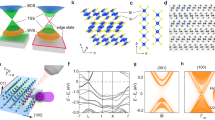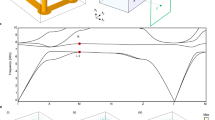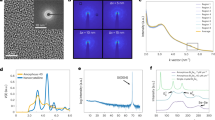Abstract
A topological insulator1,2,3,4,5,6,7,8,9 is a new state of quantum matter that is characterized by a finite energy gap in the bulk and gapless modes flowing along the boundaries that are robust against disorder scattering. The topological protection of the surface state could be useful for both low-power electronics10 and error-tolerant quantum computing11,12. For a thin slab of three-dimensional topological insulator, the boundary modes from the opposite surfaces may be coupled by quantum tunnelling, so that a small, thickness-dependent gap is opened up13,14,15. Here we report such results from angle-resolved photoemission spectroscopy on Bi2Se3 films of various thicknesses grown by molecular beam epitaxy. The energy gap opening is clearly seen when the thickness is below six quintuple layers. The gapped surface states also exhibit sizeable Rashba-type spin–orbit splitting because of the substrate-induced potential difference between the two surfaces. The tunable gap and the spin–orbit coupling make these topological thin films ideal for electronic and spintronic device applications.
This is a preview of subscription content, access via your institution
Access options
Subscribe to this journal
Receive 12 print issues and online access
$259.00 per year
only $21.58 per issue
Buy this article
- Purchase on SpringerLink
- Instant access to full article PDF
Prices may be subject to local taxes which are calculated during checkout



Similar content being viewed by others
Change history
12 August 2010
On the first page of the PDF and printed versions of this Letter originally published, the full list of authors and their affiliations should have been included. This has now been corrected on the PDF version of the Letter.
References
Qi, X-L. & Zhang, S-C. The quantum spin Hall effect and topological insulators. Phys. Today 63, 33–38 (2010).
Hasan, M. Z. & Kane, C. L. Topological insulators. Preprint at http://arxiv.org/abs/1002.3895 (2010).
Bernevig, B. A., Hughes, T. L. & Zhang, S-C. Quantum spin Hall effect and topological phase transition in HgTe quantum wells. Science 314, 1757–1761 (2006).
König, L. M. et al. Quantum spin Hall insulator state in HgTe quantum wells. Science 318, 766–770 (2007).
Fu, L., Kane, C. L. & Mele, E. J. Topological insulators in three dimensions. Phys. Rev. Lett. 98, 106803 (2007).
Hsieh, D. et al. A topological Dirac insulator in a quantum spin Hall phase. Nature 452, 970–974 (2008).
Qi, X-L., Hughes, T. L. & Zhang, S-C. Topological field theory of time-reversal invariant insulators. Phys. Rev. B 78, 195424 (2008).
Hsieh, D. et al. Observation of unconventional quantum spin textures in topological insulator. Science 323, 919–922 (2009).
Nishide, A. et al. Direct mapping of the spin-filtered surface bands of a three-dimensional quantum spin Hall insulator. Phys. Rev. B 81, 041309(R) (2010).
Žutić, I., Fabian, J. & Das Sarma, S. Spintronics: Fundamentals and applications. Rev. Mod. Phys. 76, 323–410 (2004).
Nayak, C. et al. Non-abelian anyons and topological quantum computation. Rev. Mod. Phys. 80, 1083–1159 (2008).
Moore, J. Topological insulators: The next generation. Nature Phys. 5, 378–380 (2009).
Linder, J., Yokoyama, T. & Sudbø, A. Anomalous finite size effects on surface states in the topological insulator Bi2Se3 . Phys. Rev. B 80, 205401 (2009).
Liu, C-X. et al. Oscillatory crossover from two dimensional to three dimensional topological insulators. Phys. Rev. B 81, 041307(R) (2010).
Lu, H-Z. et al. Massive Dirac fermions and spin physics in an ultrathin film of topological insulator. Phys. Rev. B 81, 115407 (2010).
Zhang, H. J. et al. Topological insulators in Bi2Se3, Bi2Te3 and Sb2Te3 with a single Dirac cone on the surface. Nature Phys. 5, 438–442 (2009).
Xia, Y. et al. Observation of a large-gap topological-insulator class with a single Dirac cone on the surface. Nature Phys. 5, 398–402 (2009).
Hsieh, D. et al. A tunable topological insulator in the spin helical Dirac transport regime. Nature 460, 1101–1105 (2009).
Chen, Y. L. et al. Experimental realization of a three-dimensional topological insulator, Bi2Te3 . Science 325, 178–181 (2009).
Zhang, G. et al. Quintuple-layer epitaxy of thin films of topological insulator Bi2Se3 . Appl. Phys. Lett. 95, 053114 (2009).
Peng, H. et al. Aharonov–Bohm interference in topological insulator nanoribbons. Nature Mater. advance online publication, 10.1038/nmat2609 (13 December 2009).
Zhou, B. et al. Finite size effects on helical edge states in a quantum spin-Hall system. Phys. Rev. Lett. 101, 246807 (2008).
Hor, Y. S. et al. p-type Bi2Se3 for topological insulator and low-temperature thermoelectric applications. Phys. Rev. B 79, 195208 (2009).
Chiang, T-C. Photoemission studies of quantum well states in thin films. Surf. Sci. Rep. 39, 181–235 (2000).
Shan, W-Y., Lu, H-Z. & Shen, S-Q. Effective continuous model for surface states and thin films of three-dimensional topological insulators. New J. Phys. 12, 043048 (2010).
Demuth, J. E. et al. Photoemission-based photovoltage probe of semiconductor surface and interface electronic structure. Phys. Rev. Lett. 56, 1408–1411 (1986).
Alonso, M., Cimino, R. & Horn, K. Surface photovoltage effects in photoemission from metal–GaP (110) interfaces: Importance for band bending evaluation. Phys. Rev. Lett. 64, 1947–1950 (1990).
Datta, S. & Das, B. Electronic analog of the electro-optic modulator. Appl. Phys. Lett. 56, 665–667 (1990).
Ast, C. R. et al. Giant spin splitting through surface alloying. Phys. Rev. Lett. 98, 186807 (2007).
Acknowledgements
This work was supported by the National Science Foundation and Ministry of Science and Technology of China and RGC of Hong Kong, China under grant No. HKU 7037/08P. X-L.Q., S-C.Z. and Q.N. are supported by the Department of Energy, Office of Basic Energy Sciences, Division of Materials Sciences and Engineering, under contracts DE-AC02-76SF00515 and DE-FG03-02ER45958.
Author information
Authors and Affiliations
Contributions
K.H., S-Q.S., X-C.M. and Q-K.X. conceived and designed the experiments. Y.Z., K.H. and C-Z.C. carried out MBE growth and ARPES measurements. C-L.S. carried out substrate preparation and STM observation. L-L.W., X.C., J-F.J., X-C.M. and Q-K.X. assisted in the experiments. W-Y.S. and S-Q.S. carried out the theoretical analyses and data interpretations. Q.N., Z.F., X.D., X-L.Q. and S-C.Z. assisted in the theoretical analyses. Y.Z., K.H., S-Q.S., S-C.Z. and Q-K.X. prepared the manuscript.
Corresponding authors
Ethics declarations
Competing interests
The authors declare no competing financial interests.
Rights and permissions
About this article
Cite this article
Zhang, Y., He, K., Chang, CZ. et al. Crossover of the three-dimensional topological insulator Bi2Se3 to the two-dimensional limit. Nature Phys 6, 584–588 (2010). https://doi.org/10.1038/nphys1689
Received:
Accepted:
Published:
Issue date:
DOI: https://doi.org/10.1038/nphys1689
This article is cited by
-
Review of 2D Bi2X3 (X = S, Se, Te): from preparation to photodetector
Rare Metals (2024)
-
Surface coupling in Bi2Se3 ultrathin films by screened Coulomb interaction
Nature Communications (2023)
-
All-optical observation of giant spin transparency at the topological insulator BiSbTe1.5Se1.5/Co20Fe60B20 interface
NPG Asia Materials (2023)
-
Single-particle properties of topological Wannier excitons in bismuth chalcogenide nanosheets
Scientific Reports (2023)
-
Axion insulator state in hundred-nanometer-thick magnetic topological insulator sandwich heterostructures
Nature Communications (2023)



